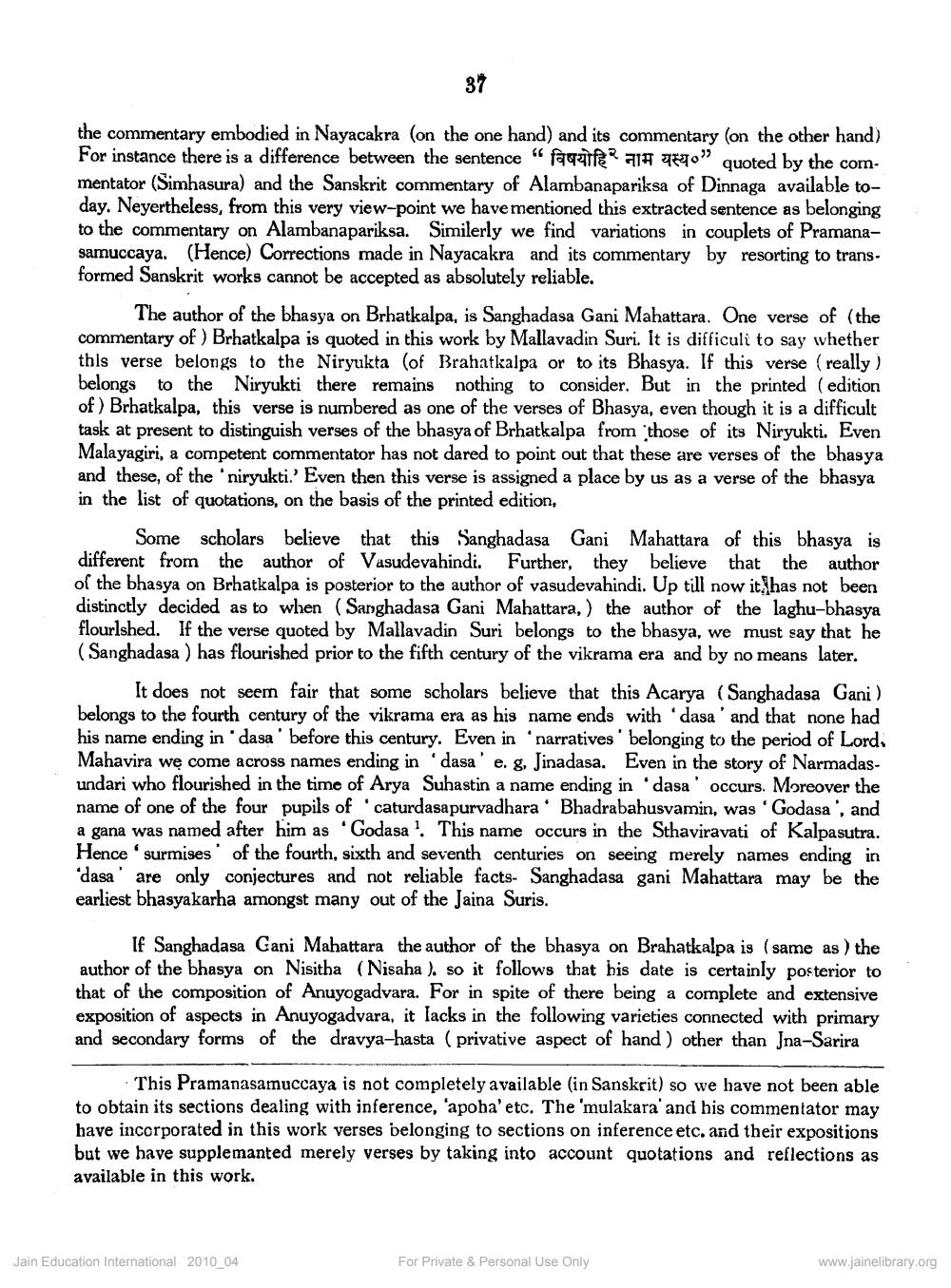________________
37
the commentary embodied in Nayacakra (on the one hand) and its commentary (on the other hand) For instance there is a difference between the sentence" faqat 21h 4640" quoted by the commentator (Simhasura) and the Sanskrit commentary of Alambanapariksa of Dinnaga available today. Neyertheless, from this very view-point we have mentioned this extracted sentence as belonging to the commentary on Alambanapariksa. Similerly we find variations in couplets of Pramanasamuccaya. (Hence) Corrections made in Nayacakra and its commentary by resorting to transformed Sanskrit works cannot be accepted as absolutely reliable.
The author of the bhasya on Brhatkalpa, is Sanghadasa Gani Mahattara. One verse of the commentary of ) Brhatkalpa is quoted in this work by Mallavadin Suri. It is difficuli to say whether this verse belongs to the Niryukta (of Brahatkalpa or to its Bhasya. If this verse (really) belongs to the Niryukti there remains nothing to consider. But in the printed (edition of) Brhatkalpa, this verse is numbered as one of the verses of Bhasya, even though it is a difficult task at present to distinguish verses of the bhasya of Brhatkalpa from those of its Niryukti. Even Malayagiri, a competent commentator has not dared to point out that these are verses of the bhasya and these, of the niryukti.' Even then this verse is assigned a place by us as a verse of the bhasya in the list of quotations, on the basis of the printed edition,
Some scholars believe that this Sanghadasa Gani Mahattara of this bhasya is different from the author of Vasudevahindi. Further, they believe that the author of the bhasya on Brhatkalpa is posterior to the author of vasudevahindi. Up till now it has not been distinctly decided as to when (Sanghadasa Gani Mahattara,) the author of the laghu-bhasya flourlshed. If the verse quoted by Mallavadin Suri belongs to the bhasya, we must say that he (Sanghadasa ) has flourished prior to the fifth century of the vikrama era and by no means later.
It does not seem fair that some scholars believe that this Acarya (Sanghadasa Gani) belongs to the fourth century of the vikrama era as his name ends with 'dasa' and that none had his name ending in dasa' before this century. Even in 'narratives' belonging to the period of Lord. Mahavira we come across names ending in 'dasa' e. g. Jinadasa. Even in the story of Narmadasundari who flourished in the time of Arya Suhastin a name ending in 'dasa' occurs. Moreover the name of one of the four pupils of 'caturdasapurvadhara. Bhadrabahusvamin, was 'Godasa', and a gana was named after him as 'Godasa! This name occurs in the Sthaviravati of Kalpasutra. Hence surmises' of the fourth, sixth and seventh centuries on seeing merely names ending in dasa' are only conjectures and not reliable facts. Sanghadasa gani Mahattara may be the earliest bhasyakarha amongst many out of the Jaina Suris.
If Sanghadasa Gani Mahattara the author of the bhasya on Brahatkalpa is (same as ) the author of the bhasya on Nisitha (Nisaha). so it follows that his date is certainly posterior to that of the composition of Anuyogadvara. For in spite of there being a complete and extensive exposition of aspects in Anuyogadvara, it lacks in the following varieties connected with primary and secondary forms of the dravya-hasta (privative aspect of hand) other than Jna-Sarira
This Pramanasamuccaya is not completely available in Sanskrit) so we have not been able to obtain its sections dealing with inference, 'apoha' etc. The 'mulakara' and his commentator may have incorporated in this work verses belonging to sections on inference etc. and their expositions but we have supplemanted merely verses by taking into account quotations and reflections as available in this work.
Jain Education International 2010_04
For Private & Personal Use Only
www.jainelibrary.org




